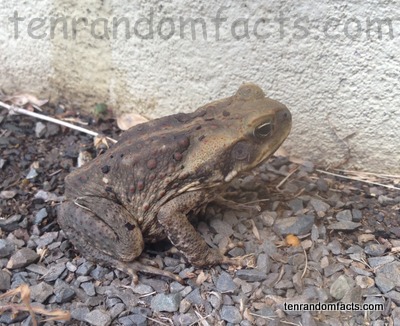Cane toads are more than just a bump in the ecosystem.
- Cane toads are a species of toad native to southern areas of North America, to the northern half of South America, and they are notoriously regarded as a pest in many other countries.
- The scientific name of a cane toad is Rhinella marina, although previously listed as Bufo marinus, and it is from the family Bufonidae, the family of true toads.
- ‘Cane toads’ are also known as ‘marine toads’, ‘giant toads’, ‘giant marine toads’ and ‘giant neotropical toads’.
- Cane toads are generally 10 to 15 centimetres (4 to 6 inches) in length and weigh an average of 500 to 800 grams (1.1 to 1.7 pounds), however, they can grow to be more than double the average size.
- The skin of cane toads is dry and has wart like bumps, and can vary in colour from shades of brown, grey, yellow or olive.
- Cane toads have been introduced in Australia, the Pacific, the United States and other countries, primarily to control pests on sugar cane, particularly the cane beetle, however, they have instead become highly invasive in some areas and fatal to native animals when eaten.
- The diet of cane toads consists of insects, rodents, birds, reptiles, amphibians, and the odd vegetation, and they will also eat pet food.
- The skin of cane toads, as well as the glands behind their head, contains bufotoxin, making them poisonous to touch or consume, to the extent of being fatal to many animals, and dangerous to humans.
- Cane toad toxin has been collected and used as an arrow poison and a drug, while some parts, including skinned legs, are edible.
- Female cane toads may produce from 8000 to 35,000 eggs every six months, breeding in water, and they have an average lifespan of five to ten years.
Bibliography:
Cameron E, Cane Toad, 2015, Australian Museum, http://australianmuseum.net.au/cane-toad
Cane Toad, 2015, National Geographic, http://animals.nationalgeographic.com.au/animals/amphibians/cane-toad/
Cane Toad, 2015, Wikipedia, https://en.wikipedia.org/wiki/Cane_toad
Draft risk assessment report to amend the Live Import List to include Cane Toads, n.d, Australian Government Department of the Environment, http://secure.environment.gov.au/biodiversity/wildlife-trade/invitecomment/pubs/draft-risk-assessment-report-bufo-marinus.pdf







